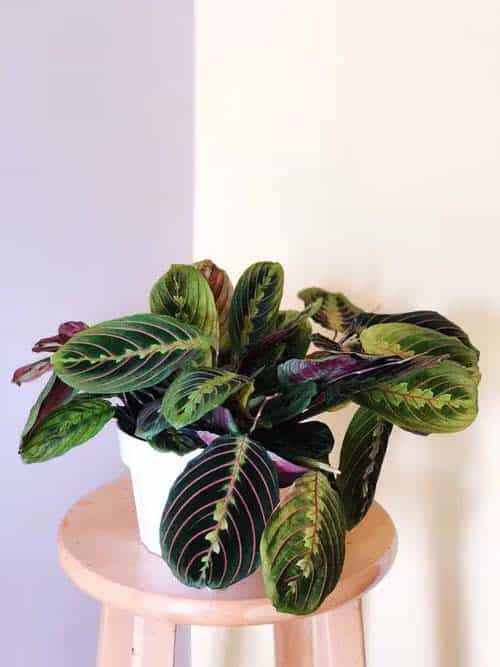Elevate your indoor landscape with the vibrant charm of tricolor houseplants. These stunning specimens offer the same invigorating presence as traditional plants, plus an added splash of color to brighten up any space. Choose from a palette of hues that evoke warmth and coziness, such as red and pink accents, or opt for a cool and modern twist with purple-tinged leaves.
With their diverse array of leaf shapes and sizes, tricolor houseplants provide the perfect solution for every room in the house, whether it’s a cozy corner or a spacious living area.
Bolero Tricolor
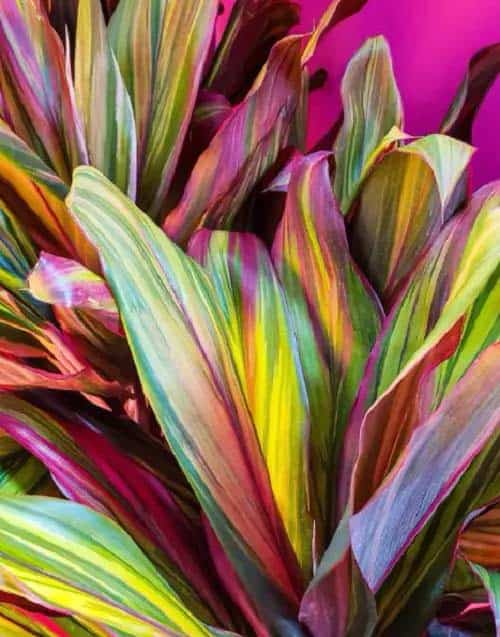
The Bolero Tricolor’s leaves are truly a feast for the eyes, boasting a kaleidoscope of yellow, purple, and green hues that resemble tiny masterpieces. Measuring wide and tall, each leaf contributes to the plant’s lush appearance, making it an ideal choice for modern spaces or bohemian-inspired homes. Whether you opt for a single pot or arrange multiple plants together, this stunning specimen is sure to bring a burst of color and vibrancy to any room.
For those interested in learning more about this botanical beauty, its botanical name is Cordyline fruticosa ‘Bolero Tricolor’.
Candy Cane
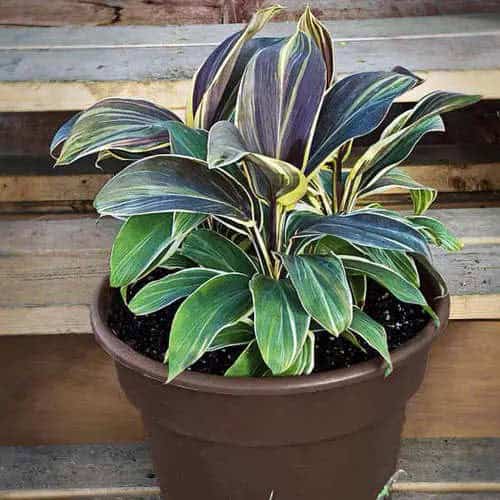
The Candy Cane plant’s unique characteristic is its striped foliage, reminiscent of festive holiday treats. The varying shades of green and vibrant yellow edges create an eye-catching display. While the most common versions feature these colors, you can also find options with bold red accents or entirely red leaves. This adaptable perennial excels in diverse conditions, tolerating both full sun and partial shade. In fact, a sunny location will yield the most radiant foliage.
Chinese Evergreen Tricolor
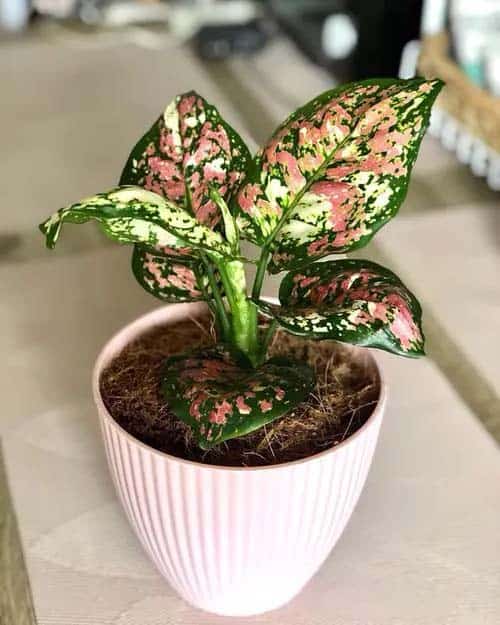
The Chinese Evergreen’s captivating appearance sets it apart from other tricolor plants. Its leaves boast an intriguing camouflage-style pattern, showcasing three distinct colors. Some varieties display a harmonious blend of green hues, while others present a striking combination of dark green, light green, and pink. This low-maintenance plant is ideal for rooms with limited natural light, as it thrives in conditions without direct sunlight.
The Aglaonema pictum tricolor’s botanical name is attributed to Plant Nurse Jesa.
Cleopatra Snake Plant
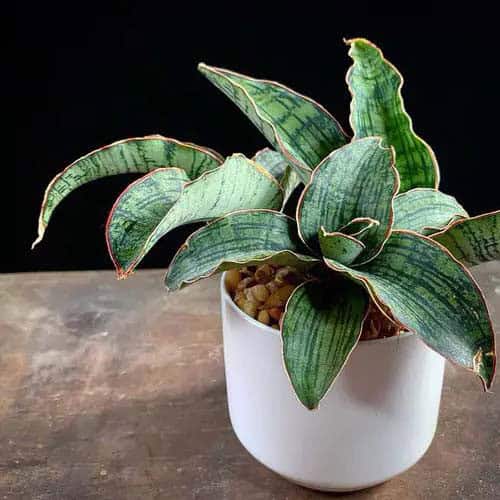
The elusive Cleopatra Snake Plant – a treasure worth searching for! This stunning species boasts a distinctive leaf pattern that adds depth and visual interest to any space. Its one-of-a-kind rosette-style arrangement sets it apart from other plants, making it a unique addition to any collection. As an added bonus, the slow growth rate of this plant makes it perfect for apartment dwellers who want a low-maintenance yet stylish greenery.
Corona Tricolor Plant
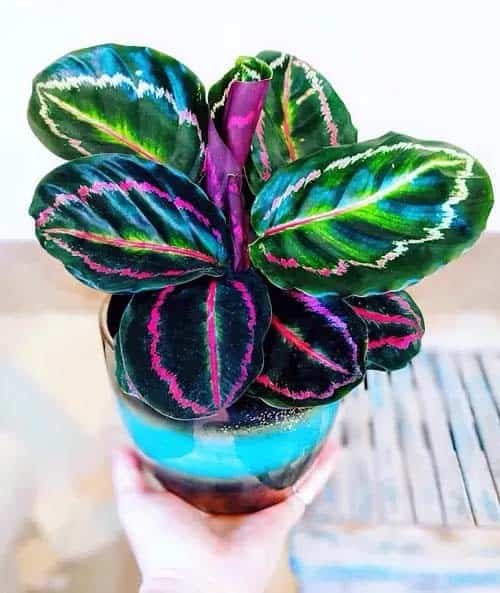
The Calathea Roseopicta ‘Corona’ is an eye-catching addition to any room, captivating visitors with its unique appearance. The plant’s deep green leaves are adorned with intricate patterns of contrasting green and pink hues, making it a stunning centerpiece for a plant stand or shelf. What’s more, the waxy texture of its leaves catches the light beautifully, adding an extra layer of visual interest.
And, unlike some other plants that require direct sunlight, this beauty thrives in bright but indirect light, making it a great choice for rooms with limited natural light.
Flapjack
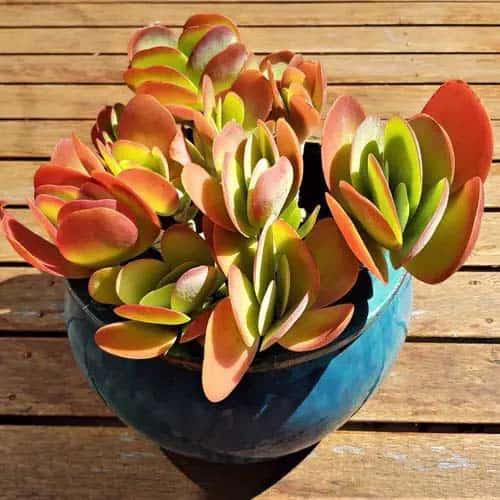
The Flapjack houseplant is a succulent that can be easily identified by its leaves, which resemble tiny clam shells growing in small clusters, resembling the petals of a flower. This low-maintenance option makes it an ideal choice for those new to plant care. As long as it’s placed in a warm and sunny spot, the Flapjack thrives with minimal watering and pruning requirements. With the botanical name Kalanchoe thyrsiflora, this variety is a great option for succulent enthusiasts.
Gingerland Plant
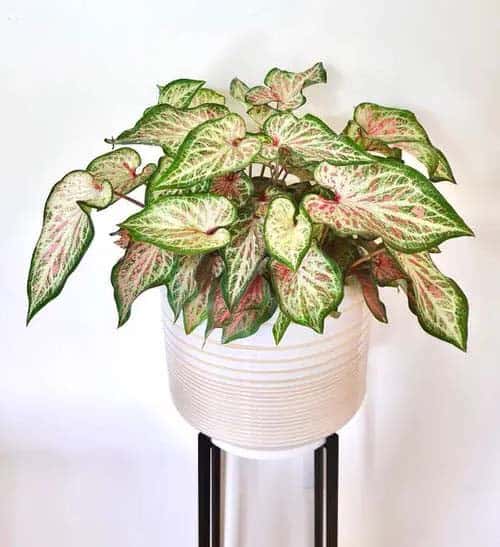
The Caladium ‘Gingerland’ plant, also known as Angel Wings, derives its nickname from the striking shape of its leaves. Each leaf features two distinct lobes and a slender, elongated tip, imbuing them with an air of elegance. The characteristic color scheme of most Caladium varieties is also on display here, with dark green margins surrounding pale green centers and deep red accents adding a pop of vibrancy.
One of the plant’s greatest strengths is its adaptability to indoor conditions, requiring only a few hours of direct sunlight per day to thrive. As such, it’s an ideal choice for apartments or rooms with limited window space.
Lauren’s Rainbow Croton
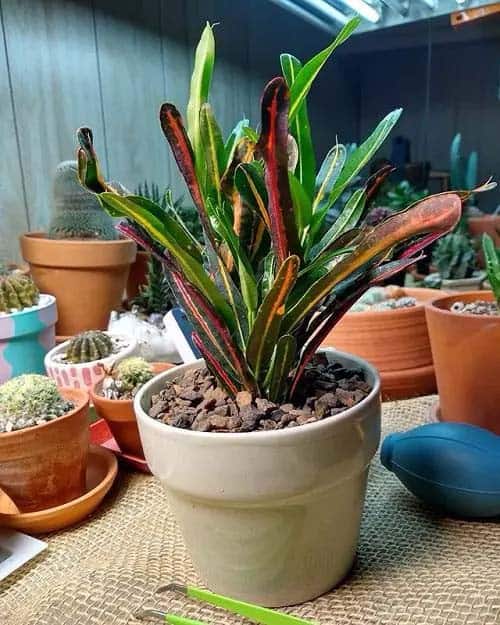
Looking for a statement houseplant that makes a bold impression? The Lauren’s Rainbow Croton (Codiaeum variegatum ‘Lauren’s Rainbow’) is an excellent choice. Its slender, upright leaves grow vertically, giving it a tree-like appearance. What truly sets this plant apart is its vibrant coloration – the green leaves display bursts of orange, yellow, and red hues. For maximum color intensity, place this beauty in bright, direct sunlight.
Moonburst
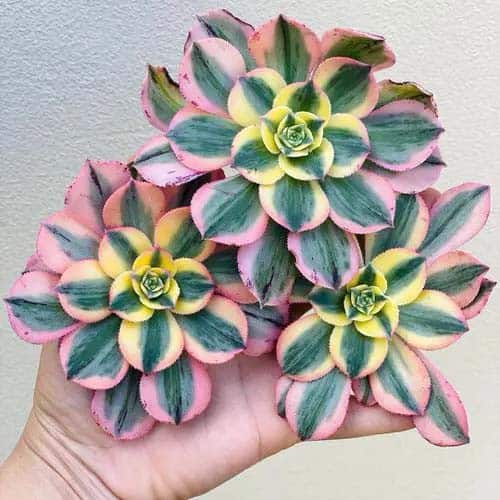
The Aeonium ‘Moonburst’ aptly deserves its enchanting moniker. Its unique combination of muted hues – think soft greens, pinks, and yellows – harmonizes with the plant’s distinctive rosette shape to evoke an ethereal quality. The rounded leaves, each featuring a diminutive point, add to the Moonburst’s extraterrestrial charm. As this succulent matures, it expands into a more majestic, spherical form, further enhancing its visual allure.
Its succulent nature makes maintenance a cinch, freeing you to appreciate its otherworldly beauty. Aeonium ‘Moonburst’ via Succulents By Fay
Nidularium Houseplant
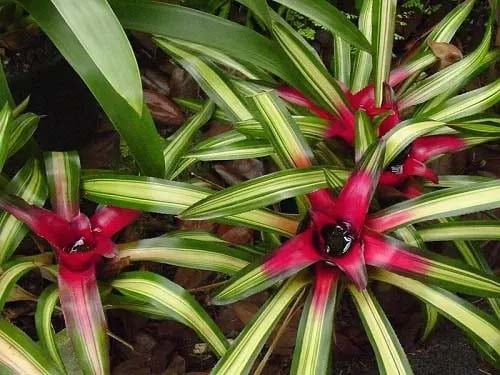
The Nidularium Bromeliad is unmistakable due to its vibrant red centerpiece, which provides a striking contrast to the lush tropical green of its leaves. This unique combination creates an eye-catching visual effect that sets it apart from other plants. To thrive, the Nidularium prefers bright, indirect sunlight and high humidity, making it a great choice for kitchens or bathrooms. With an average lifespan of 2-5 years, this plant is a delightful addition to any space.
Rainbow Peperomia
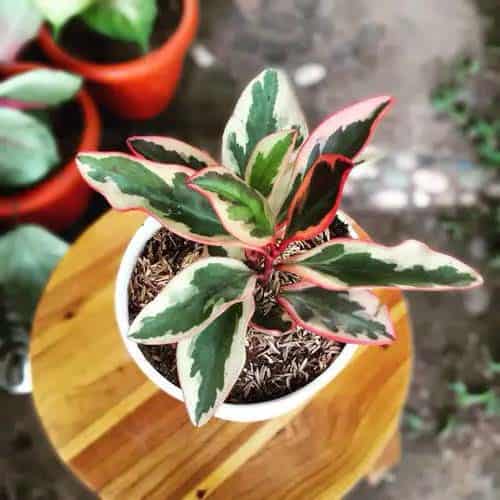
If you’re searching for a compact houseplant to brighten up your small space, the Rainbow Peperomia is an excellent choice. Its striking leaves boast pale green edges and dark green centers, often featuring subtle red or pink accents. As each leaf grows upwards, the plant occupies minimal floor space, making it perfect for cozy corners or tight spots.
With its botanical name being Peperomia clusiifolia ‘Rainbow’, this stunning specimen is available through reputable sellers like Dipuri Plants.
Red Prayer Plant
The Red Prayer Plant (Maranta leuconeura ‘Erythroneura’) is renowned for its striking vein patterns, which are a true showstopper. Each oval-shaped leaf boasts vibrant pink veins that starkly contrast against the dark green surface. Upon closer inspection, one can notice that these veins are subtly offset from the center of the leaf. As the day winds down and the light fades, the leaves fold inward in a manner that evokes the image of praying hands, hence its namesake inspiration.
This plant is relatively low-maintenance, requiring only occasional watering every two weeks as long as it’s situated in a well-lit area with ample humidity.
Rosebud Houseplant
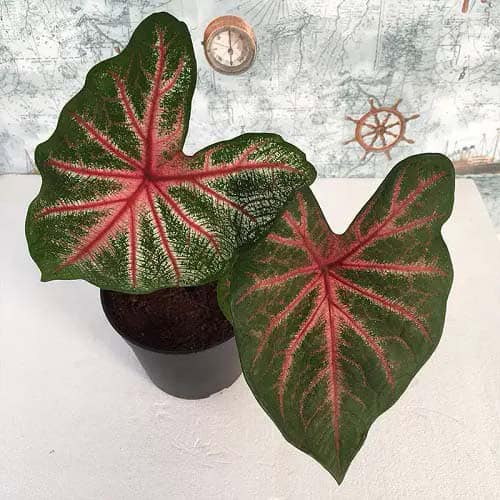
The Rosebud houseplant is instantly recognizable due to its large, heart-shaped leaves, which can make it an impressive addition to any indoor space. As the leaves grow, they develop thrilling patterns featuring splashes of red or pink, adding a touch of tropical beauty to your decor. To keep this plant thriving, it’s essential to provide a humid environment with plenty of warmth.
However, it’s worth noting that Caladium ‘Rosebud’ contains toxic compounds that can be harmful if ingested, making it unsuitable for homes with pets or young children. With proper care and conditions, the Rosebud houseplant can be a stunning addition to your home, but it’s crucial to keep its toxicity in mind when deciding whether to bring one into your space.
Tricolor Stonecrop
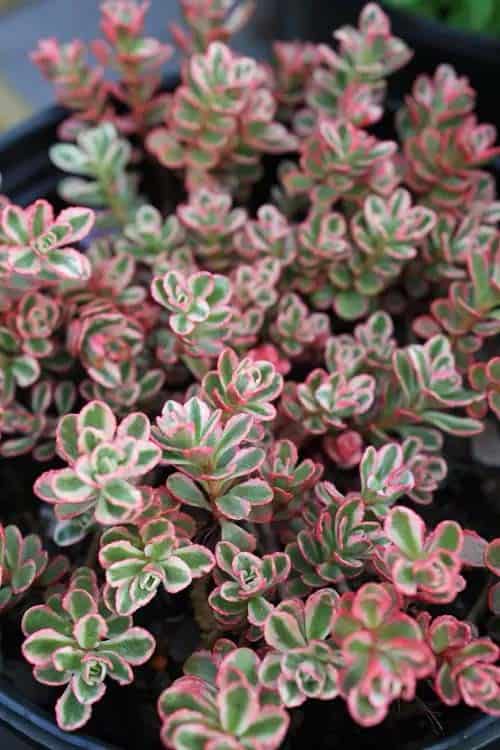
The Tricolor Stonecrop, with its botanical name Sedum spurium ‘Tricolor’, is a petite yet captivating houseplant. Its intricate leaves feature a vibrant green center, subtle pale green edges, and a delicate pink rim, creating an endearing appearance that belies its compact stature. Typically growing no taller than 6 inches, this charming plant flourishes in well-lit conditions and expansive containers, rapidly filling the space it’s provided with its lush foliage.
Tricolor Stromanthe
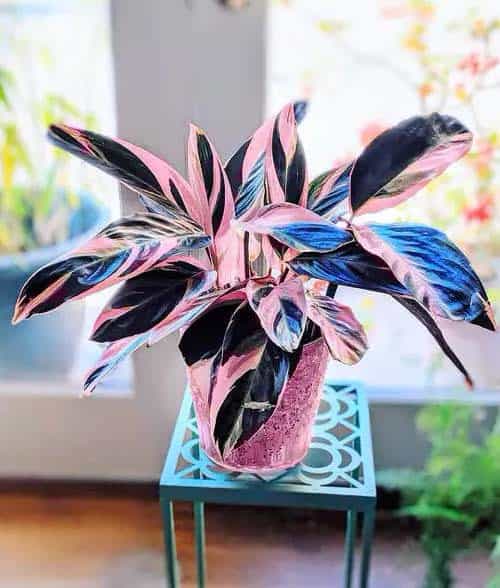
The Tricolor Stromanthe is an eye-catching houseplant, characterized by its striking large leaves featuring pastel-colored stripes on a deep green background. Despite its size, the plant’s upward-growing leaves make it suitable for placement on the floor or a plant stand. For optimal growth and thriving, ensure this tropical beauty receives sufficient light and warmth, as it has a strong affinity for sunshine.
